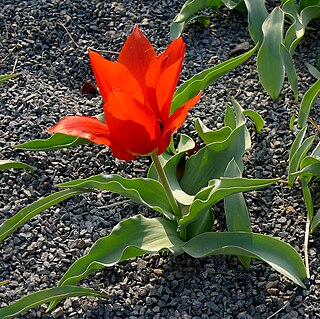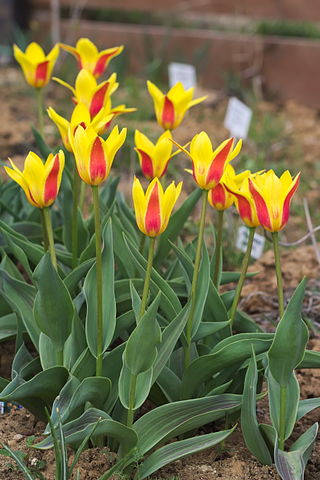
The lily family, Liliaceae, consists of about 15 genera and 610 species of flowering plants within the order Liliales. They are monocotyledonous, perennial, herbaceous, often bulbous geophytes. Plants in this family have evolved with a fair amount of morphological diversity despite genetic similarity. Common characteristics include large flowers with parts arranged in threes: with six colored or patterned petaloid tepals arranged in two whorls, six stamens and a superior ovary. The leaves are linear in shape, with their veins usually arranged parallel to the edges, single and arranged alternating on the stem, or in a rosette at the base. Most species are grown from bulbs, although some have rhizomes. First described in 1789, the lily family became a paraphyletic "catch-all" (wastebasket) group of lilioid monocots that did not fit into other families and included a great number of genera now included in other families and in some cases in other orders. Consequently, many sources and descriptions labelled "Liliaceae" deal with the broader sense of the family.

Tulipa pulchella is a dwarf species of flowering plant in the family Liliaceae, native to Iran and Turkey. It grows from a bulb 1–2 cm diameter, which produces a flowering stem up to 20 cm tall. The leaves are glaucous-green, 10–15 cm long. The flowers are reddish-purple, with six tepals 3 cm long and 1.5 cm broad.

Tulipa turkestanica, the Turkestan tulip, is a species of tulip native to Central Asia. It was first described by Eduard August von Regel in 1873 as a variety of T. sylvestris, then elevated to full species status two years later.

Tulips are spring-blooming perennial herbaceous bulbiferous geophytes in the Tulipa genus. Their flowers are usually large, showy, and brightly coloured, generally red, orange, pink, yellow, or white. They often have a different coloured blotch at the base of the tepals, internally. Because of a degree of variability within the populations and a long history of cultivation, classification has been complex and controversial. The tulip is a member of the lily family, Liliaceae, along with 14 other genera, where it is most closely related to Amana, Erythronium, and Gagea in the tribe Lilieae.

Heinrich Carl Haussknecht was a German pharmacist and botanical collector who was a native of Bennungen, Sachsen-Anhalt.

Tulipa urumiensis, the late tulip or tardy tulip, is a species of flowering plant in the family Liliaceae. It is a perennial growing from a bulb. By some sources the accepted name is Tulipa tarda. It has a leathery tunic that is glabrous on the inside. It has up to seven linear green leaves that can be up to 20 cm long. The stem is between 4 and 20 cm long. The yellow flowers have white tips, anthers and stamen are yellow.

Fritillaria acmopetala, the pointed-petal fritillary, is a species of flowering plant in the lily family Liliaceae, native to rocky limestone mountain slopes in the Middle East. It was described by the Swiss botanist Pierre Edmond Boissier in 1846.

Tulipa armena is a species of flowering plant in the Liliaceae family. It is referred to by the common name Armenian tulip, and is native to the historical Armenian Highlands as the name implies; current regions of Armenia, modern day Turkey, Iran, South Caucasus, and Azerbaijan.

Tulipa humilis is a species of flowering plant in the lily family Liliaceae, found in Syria, Lebanon, Palestine, Turkey, Iran, and the North Caucasus region of Russia. The flowers are pink with yellow centers. Its preferred habitat are rocky mountain slopes. It is known by several other names in horticulture.

Tulipa sprengeri, or Sprenger's tulip, is a wild tulip from the Pontic coast of Turkey. It is quite rare and possibly extinct in the wild, but widely cultivated as an ornamental.

Tulipa suaveolens, synonym Tulipa schrenkii, the van Thol tulip or Schrenck's tulip, is a bulbous herbaceous perennial of species of tulip (Tulipa) in the family of the Liliaceae. It belongs to the section Tulipa. It is the probable wild ancestor of the garden tulip.

Tulipa dasystemon, synonym Tulipa neustruevae, is a bulbous herbaceous perennial species of tulip (Tulipa) in the family Liliaceae. It belongs to the section Biflores.

Tulipa eichleri, commonly known as Eichler tulip or Eichler's tulip, is a species of tulip. It is a bulbous flowering perennial with long green leaves,deep red flowers with a central black blotch, coming from the Caucasus Mountains.

Tulipa hungarica, the Danube tulip, Banat tulip or Rhodope tulip, is a species of flowering plant in the family Liliaceae. It is also in the subgenus Tulipa. It is found on the rocky mountainsides of Bulgaria, Romania, Hungary and Slovenia, especially along the gorges of the river Danube. It has small bright yellow flowers in spring and blue-grey leaves.

Tulipa alberti, or Albert's tulip, is a species of flowering plant in the family Liliaceae. It has long reddish, orange or pink flowers. It comes from the mountains of Central Asia.

The taxonomy of Tulipa places the genus in the family Liliaceae, and subdivides it as four subgenera, and comprises about 75 species.

Tulipa orphanidea is a species of flowering plant in the Liliaceae family. It was described by Pierre Edmond Boissier and Theodor Heinrich Hermann von Heldreich (1862).

Tulipa fosteriana is a species of tulip, native to the Pamir Mountains and nearby areas of Afghanistan, Kyrgyzstan, Tajikistan and Uzbekistan.

Tulipa kaufmanniana, the water lily tulip, is a species of tulip native to Central Asia.

Tulipa greigii, is a species of tulip native to Central Asia and Iran.


















